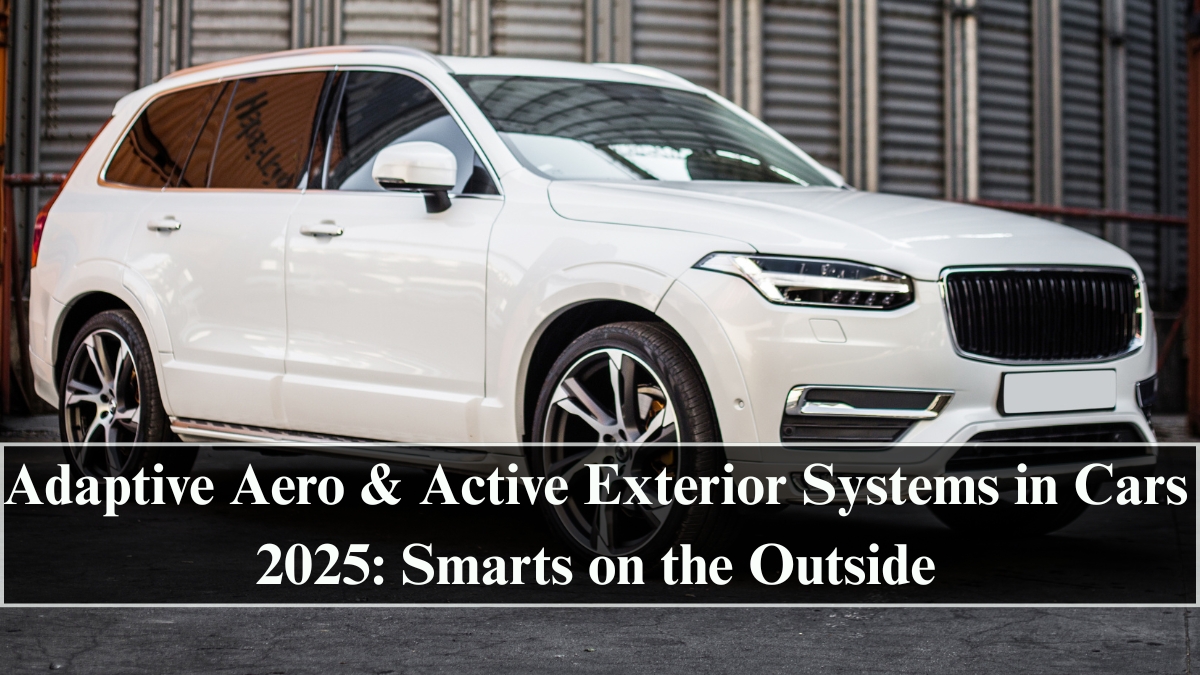In 2025, car design is no longer static — it’s alive, intelligent, and in motion. Adaptive aero and active exterior systems represent a major leap in vehicle innovation, where cars dynamically adjust their shape, airflow, and surface elements to optimize performance, reduce drag, and improve efficiency in real time.
As automotive design merges with advanced computing and material science, vehicles are becoming responsive entities — able to change aerodynamics depending on driving conditions, speed, and weather. This evolution is redefining not just how cars move, but how they think about movement itself.

The Evolution of Aerodynamics in Modern Cars
For decades, automotive aerodynamics focused on fixed designs — sculpted shapes and spoilers intended to minimize drag. However, these solutions were always a compromise between stability, performance, and efficiency.
In 2025, adaptive aerodynamics has eliminated that compromise. Cars now use smart actuators, AI-driven airflow sensors, and morphing surfaces to modify their physical structure instantaneously.
These systems actively respond to real-world driving data — adjusting wings, vents, grilles, and even wheel covers — to maintain optimal performance and reduce energy consumption.
How Adaptive Aero Systems Work
Modern vehicles integrate sensors, control modules, and flexible materials that enable movement and transformation of exterior components. These components operate autonomously through continuous data feedback.
Key functions include:
-
Active Grille Shutters: Open and close automatically to regulate airflow and improve engine or battery cooling.
-
Deployable Spoilers and Splitters: Adjust angle and height for stability or drag reduction.
-
Smart Air Curtains: Direct airflow around tires and sides to minimize turbulence.
-
Morphing Body Panels: Use shape-memory alloys or electroactive polymers to adjust body contours.
-
Active Wheel Designs: Reconfigure spokes or flaps to optimize airflow during acceleration or braking.
By integrating artificial intelligence, these systems can predict aerodynamic needs based on speed, terrain, and weather conditions — effectively making aerodynamics an intelligent, real-time process.
Materials and Technologies Powering the Revolution
The foundation of adaptive aero systems lies in breakthroughs in smart materials and embedded AI control units.
Some key technologies include:
-
Shape-Memory Alloys (SMAs): Metals that return to preset shapes under specific temperatures.
-
Electroactive Polymers (EAPs): Materials that expand or contract when electric current passes through them.
-
Carbon Nanotube Composites: Offer lightweight flexibility and electrical conductivity.
-
AI Predictive Control Software: Adjusts aerodynamic components preemptively during rapid acceleration or crosswinds.
-
Integrated Thermal Sensors: Manage temperature balance between engine, battery, and body panels.
Together, these technologies enable cars to adapt with precision — balancing aesthetics, safety, and performance seamlessly.
Real-World Applications and Industry Leaders
In 2025, several automakers are leading the adaptive aero revolution, integrating active exterior systems across both electric and hybrid models:
-
Porsche Taycan Turbo GT features retractable spoilers and air curtains that adjust dynamically for speed and cooling.
-
Tesla Roadster 2.0 uses smart venting and underbody channels for improved downforce.
-
BMW i7 and iX Series employ active grille shutters and adjustable rear diffusers for aerodynamic efficiency.
-
Mercedes-AMG One incorporates Formula 1-grade adaptive aero flaps.
-
Lucid Motors and Rimac are pioneering AI-managed airflow with integrated software sensors.
These vehicles are setting new benchmarks for both energy efficiency and high-speed performance, proving that the future of speed lies in smart adaptation, not brute force.
Benefits of Adaptive and Active Exterior Systems
The adoption of adaptive aerodynamics offers measurable advantages across multiple performance metrics:
-
Increased Energy Efficiency: Reduces drag to improve fuel economy and EV range.
-
Enhanced Stability: Adjusts lift and downforce dynamically for safer handling.
-
Better Cooling: Actively directs air to critical zones like brakes and batteries.
-
Improved Acceleration: Streamlined airflow reduces resistance at high speeds.
-
Aesthetic Flexibility: Allows futuristic, shape-shifting exterior designs.
These benefits collectively enhance both sustainability and driving pleasure, making cars responsive to the environment and driver needs.
Challenges in Implementation
Despite its promise, adaptive aerodynamics faces challenges in terms of cost, durability, and maintenance. Moving parts increase mechanical complexity, and smart materials require precise calibration.
Moreover, ensuring reliability under diverse weather conditions — from freezing temperatures to desert heat — remains a key engineering hurdle. Manufacturers are addressing these issues with modular components, self-cleaning actuators, and predictive diagnostics powered by onboard AI.
By 2030, these systems are expected to become standard features in high-performance EVs, and gradually filter down to mass-market vehicles as production costs decline.
The Future of Dynamic Car Design
Adaptive aero systems symbolize a shift toward living mobility design, where vehicles continuously sense, learn, and transform. The next decade will bring cars that reshape themselves based on individual driving profiles, aerodynamic simulations, and even real-time traffic airflow data.
In essence, cars are becoming responsive organisms — vehicles that breathe, react, and adapt with precision. The future of automotive design isn’t just aerodynamic; it’s autonomous, intuitive, and alive.
FAQs
What are adaptive aerodynamic systems in cars?
They are smart systems that modify a vehicle’s shape or airflow in real time to reduce drag, increase stability, and improve efficiency.
How do active exterior systems enhance performance?
They dynamically adjust components like spoilers, grilles, and vents based on driving conditions to optimize handling and fuel or battery efficiency.
Which car brands use adaptive aerodynamics in 2025?
Porsche, BMW, Tesla, Mercedes-AMG, and Lucid Motors are leading the adoption of active exterior and aero systems.
What materials are used in adaptive aero systems?
Shape-memory alloys, electroactive polymers, and lightweight carbon composites enable flexible, responsive car surfaces.
What’s the future of adaptive car design?
By 2030, vehicles will feature fully autonomous aerodynamic intelligence — self-adjusting body panels and AI-driven airflow for maximum efficiency and performance.
Click here to know more.
